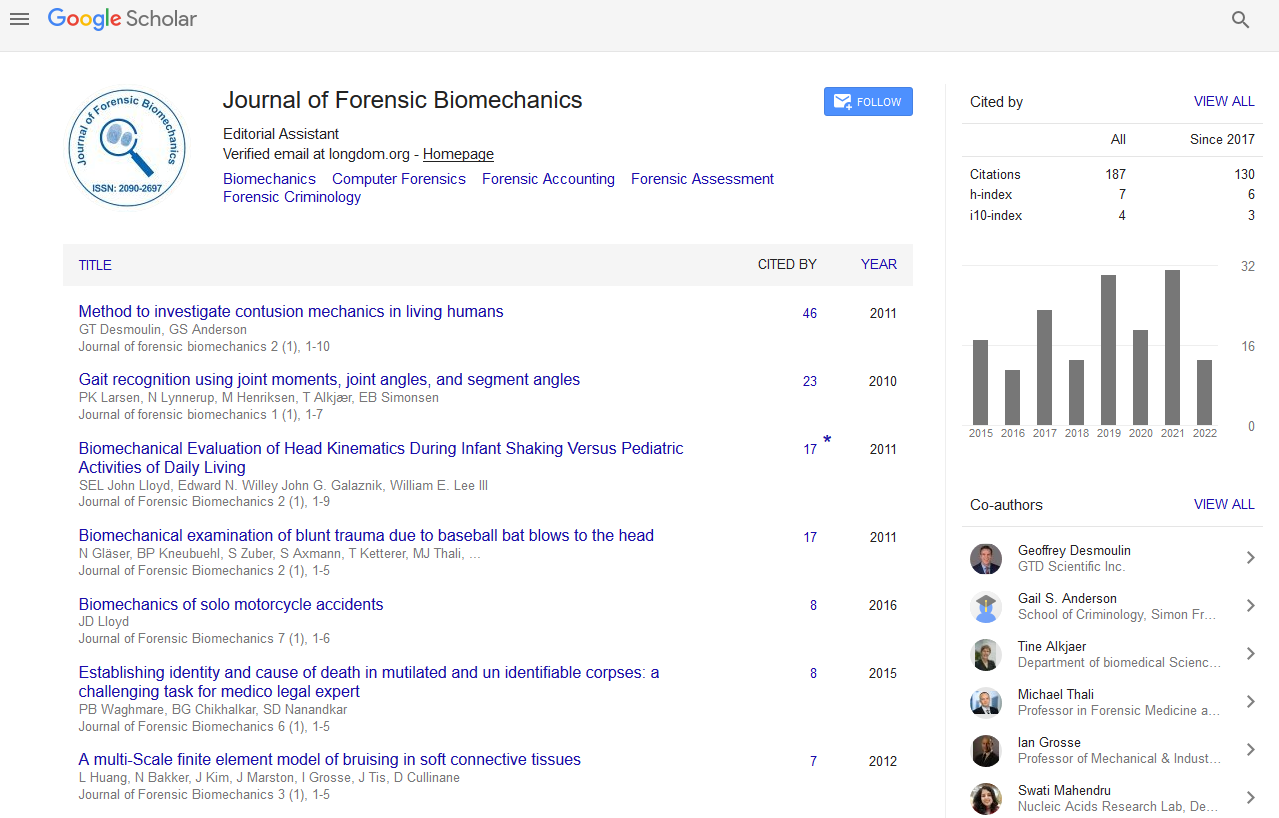Indexed In
- Genamics JournalSeek
- SafetyLit
- Ulrich's Periodicals Directory
- RefSeek
- Hamdard University
- EBSCO A-Z
- Geneva Foundation for Medical Education and Research
- Euro Pub
- Google Scholar
Useful Links
Share This Page
Journal Flyer

Open Access Journals
- Agri and Aquaculture
- Biochemistry
- Bioinformatics & Systems Biology
- Business & Management
- Chemistry
- Clinical Sciences
- Engineering
- Food & Nutrition
- General Science
- Genetics & Molecular Biology
- Immunology & Microbiology
- Medical Sciences
- Neuroscience & Psychology
- Nursing & Health Care
- Pharmaceutical Sciences
Perspective - (2022) Volume 13, Issue 2
Forensic Ballistics and Firearm Identification: An Overview
Received: 01-Mar-2022, Manuscript No. JFB-22-16063 ; Editor assigned: 03-Mar-2022, Pre QC No. JFB-22-16063(PQ); Reviewed: 17-Mar-2022, QC No. JFB-22-16063 ; Revised: 22-Mar-2022, Manuscript No. JFB-22-16063(R); Published: 29-Mar-2022, DOI: 10.35248/2090-2697.22.13.392
Description
In forensic medicine, ballistics research is the study of projectile (bullet, missile, and bomb) motion, dynamics, angular motion, and action. There are many applications of ballistics within the scope of criminal investigation. Bullets fired at crime scenes are examined in the hope of discovering more information. The actual bullet can identify the type of gun used by the criminal and whether the firearm is associated with another crime. The amount of damage the bullet takes when it hits a hard surface helps to roughly determine where the shooter was standing, the angle at which the gun was fired, and when the gun was fired. This information helps researchers identify the shooter. Even if the bullet is missing, the nature of the impact allows the investigator to determine the type of bullet used by the criminal, and the type of weapon.
Forensic ballistics involves examining evidence from firearms that may have been used in crime. When a bullet is fired from a gun, the gun leaves a fine mark on the bullet and cartridge case. These marks are like ballistic fingerprints. When an investigator retrieves a bullet from a crime scene, a forensic investigator can test the suspect's gun and compare the bullet mark on the crime scene with the test bullet mark. The examiner then evaluates how similar the two sets of marks are and determines if the bullets are likely to have been fired from the same or different guns. Bullet casings are compared in the same way. Ballistics experts are responsible to answer the questions like type of firearm used, identification of firearms, individual characteristics of firearms, shooting range, direction of shooting, identification of shooters, medical aspects (suicide/murder/accident).
Firearms and Ballistics
Firearms research is a forensic discipline focused on researching firearms and related subjects. Ballistics is closely related to this. This refers to the trajectory of the projectile and is often associated with forensic medicine when examining firearms. This area of research looks at the path of the bullet away from the firearm to hit the target. Investigations suspected of using firearms may collect a variety of artifacts for investigation including firearms, cartridge cases, bullets, live ammunition, trace substances, and substances damaged by projectiles. Firearms include smoothbore guns, rifle barrels (manual/semiautomatic/ automatic), pistols, shoulder rifles, and more.
Types of Existing Ballistics
The four categories of ballistics include internal, transition, external, and terminal ballistics. Internal ballistics describes the events from the moment the propellant is ignited to the end of the barrel of the weapon. Transition ballistics refers to the intermediate process between internal ballistics and external ballistics when the projectile exits the nozzle until pressure equalization is achieved behind the projectile. External ballistics is the flight of a bullet after leaving the barrel. Terminal ballistics refers to the specific action when a projectile hits a target.
Each time a bullet is fired, the weapon leaves a fine trace on the bullet and cartridge case which is commonly referred to as a "ballistic fingerprint." Once the bullet is recovered from the crime scene, the bullet mark from the crime scene can be compared to the bullet from the result of a test shot from the suspect's gun. This is done to show if the bullets in both settings were fired from the same gun, and uses the same comparison method for the cartridge case. Firearms inspectors use a comparison microscope to compare two samples side-by-side through two light microscopes, allowing them to see the two images in one field of view from the central eyepiece. The sample table is linked by a system called an "optical bridge" consisting of prisms, mirrors and lenses, allowing you to observe both samples at the same time.
Identification and Individualization of Firearm
The basic principle is that two firearms do not produce the same unique mark on the fired bullet and cartridge case, even if they are of the same make and model. Due to the manufacturing process surface features that cannot be accurately reproduced by other firearms remain in the firearm. When a firearm examiner compares two bullets, he considers the two categories in which the bullets can be classified as the class characteristics and the individual characteristics. Class characteristics are characteristics that associate an object with a particular source or group, and individual characteristics are characteristics of an object that can be attributed to a common source with high certainty. Bullet class characteristics can be referenced by caliber, direction of twist, and number of lands and grooves. These traits are called class traits because multiple bullets can have these traits that are not unique to a single bullet. The individual characteristics of a bullet are due to corrosion, damage, or defects and marks as a result of the tool that create the land and groove of the bullet.
Citation: Smith J (2022) Forensic Ballistics and Firearm Identification: An O verview. J Forensic Biomech. 13:392.
Copyright: © 2022 Smith J. This is an open-access article distributed under the terms of the Creative Commons Attribution License, which permits unrestricted use, distribution, and reproduction in any medium, provided the original author and source are credited.

